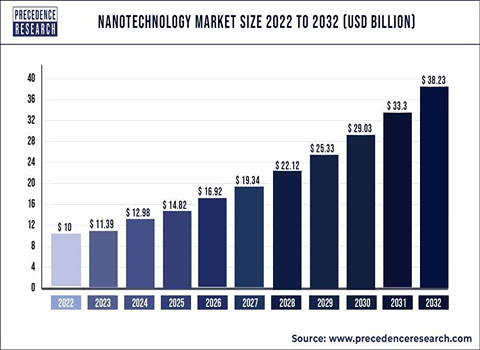The nanotechnology industry is poised for remarkable growth in the coming years, with a projected market size of US$ 38.23 billion by 2032.
This exponential growth can be attributed to the increasing adoption of nanotechnology across various sectors and the numerous advantages it offers.
Nanotechnology involves manipulating and controlling matter at the atomic and molecular levels to create materials, devices, and systems with unique properties and functionalities.
It has found applications in diverse industries such as electronics, healthcare, energy, and manufacturing.
The ability to engineer materials at such a small scale has led to the development of advanced products with enhanced performance and efficiency.
Nanotechnology market
One of the key drivers behind the growth of the nanotechnology market is the electronics sector.
Nanotechnology has enabled the advancement of smaller, faster, and more efficient electronic devices.
Nanoscale transistors, for example, have allowed for the continued miniaturization of electronic components, leading to the development of smaller and more powerful devices.
Additionally, nanotechnology has enabled the production of high-quality displays and touchscreens with improved resolution and durability.
The healthcare sector is another industry that has greatly benefited from nanotechnology.
Nanoparticles and nanoscale materials are being extensively used in drug delivery systems, allowing for targeted and controlled release of medications.
This has revolutionized the field of medicine, as it enables more effective treatments with reduced side effects.
Furthermore, nanotechnology has paved the way for advancements in diagnostic tools, such as biosensors and imaging agents, improving disease detection and monitoring.
Energy is yet another sector harnessing the potential of nanotechnology.
Nanomaterials are being employed to enhance energy storage and conversion devices.
For instance, nanotechnology has enabled the development of high-performance batteries and solar cells, facilitating the shift towards renewable energy sources.
The improved efficiency and durability of these nanomaterial-based energy solutions contribute to a more sustainable future.
The manufacturing industry has also embraced nanotechnology, driving its rapid market expansion.
Nanoscale coatings and materials are being used to enhance the properties of various manufacturing processes and products.
For instance, nanocoatings are employed to improve the scratch resistance and durability of materials, while nanomaterials are used to produce lightweight and strong composite materials.
These applications contribute to increased efficiency, reduced costs, and improved product performance in the manufacturing sector.
Shaping Industries with Small-scale Marvels
The projected market size of US$ 38.23 billion by 2032 reflects the growing demand and adoption of nanotechnology solutions across multiple industries.
However, challenges such as high initial investment costs and regulatory concerns regarding the safety of nanomaterials still need to be overcome.
Ongoing research and development efforts, as well as collaborations between academic institutions, government agencies, and industry players, are crucial in further advancing the field of nanotechnology.
Widespread adoption of nanotechnology
In conclusion, the nanotechnology market is expected to witness substantial growth in the coming years, with a projected market size surpassing US$ 38 billion by 2032.
The widespread adoption of nanotechnology across industries such as electronics, healthcare, energy, and manufacturing is driving this growth.
The numerous advantages offered by nanotechnology, such as improved performance, efficiency, and sustainability, make it a promising field for future developments.
Furthermore, nanotechnology has the potential to address some of the most pressing global challenges.
For instance, in the healthcare sector, nanotechnology is being explored for targeted cancer therapies, where nanoparticles can deliver drugs directly to tumor cells, minimizing damage to healthy tissues.
This approach holds immense promise in revolutionizing cancer treatment and improving patient outcomes.
In the energy sector, nanotechnology is being harnessed to improve the efficiency of solar panels, making renewable energy more accessible and cost-effective.
Nanotechnology-based solutions are also being explored for energy storage, with the development of high-capacity batteries and supercapacitors that can store and deliver energy more efficiently.
In the field of agriculture, nanotechnology is being used to develop smart pesticides and fertilizers that release nutrients in a controlled manner, reducing environmental impact and enhancing crop yields.
Nanosensors are also being developed to monitor soil conditions, helping farmers optimize irrigation and fertilizer usage.
The automotive industry is another area that stands to benefit from nanotechnology.
Nanocomposites, made by incorporating nanoscale fillers into traditional materials, offer improved strength, lightweight properties, and enhanced fuel efficiency.
Additionally, nanocoatings can be applied to vehicles to increase their resistance to scratches, corrosion, and wear and tear.
Despite the tremendous potential of nanotechnology, the market still faces challenges in terms of scalability, manufacturing costs, and regulatory concerns.
As such, there is a need for continued investment in research and development to overcome these hurdles and bring nanotechnology to commercial fruition.
Government initiatives and collaborations between research institutions, industry players, and regulatory bodies are crucial to promoting the safe and responsible development of nanotechnology.
Standardization and regulatory frameworks will help address concerns related to the potential health and environmental impacts of nanomaterials.
In conclusion, the projected market size of US$ 38.23 billion by 2032 reflects the growing significance of nanotechnology across industries.
From electronics and healthcare to energy and manufacturing, nanotechnology offers innovative solutions and promising advancements.
However, continued efforts in research, development, and collaboration are necessary to address challenges and unlock the full potential of nanotechnology.
As the market expands, it is essential to ensure the responsible and sustainable development of nanotechnology to reap its benefits fully.




